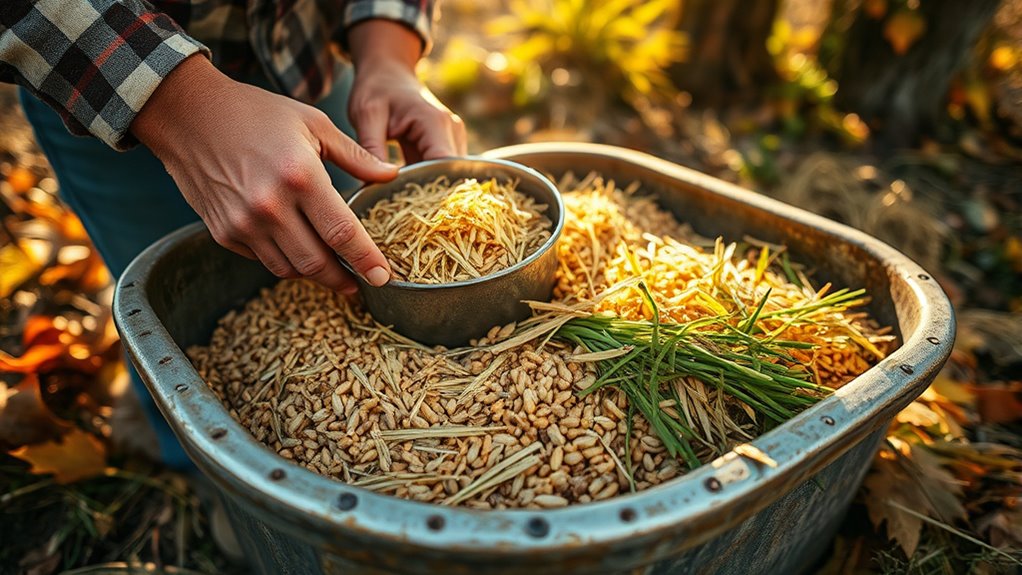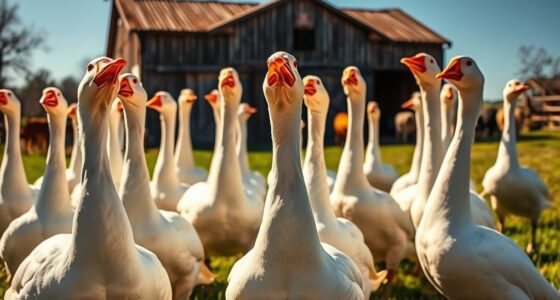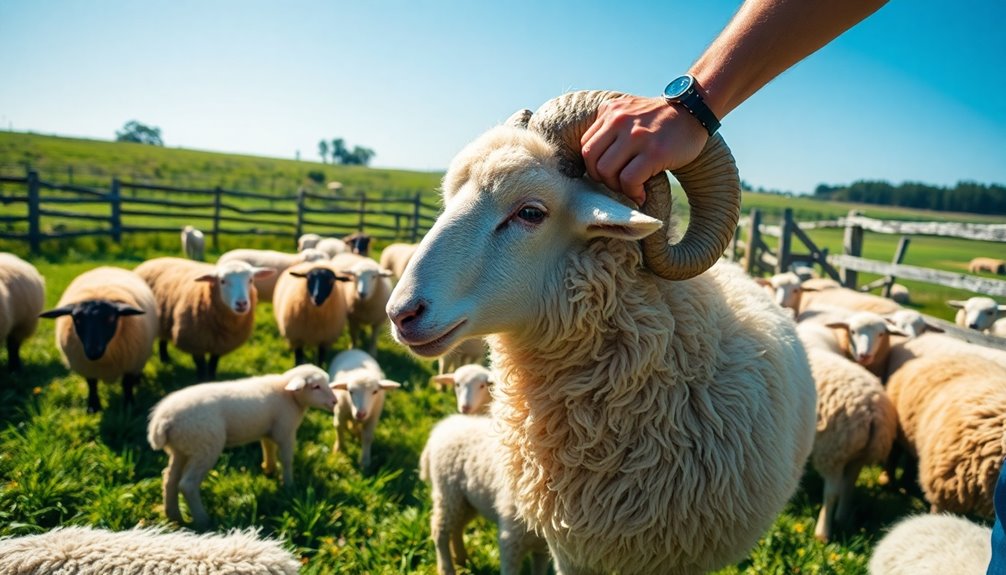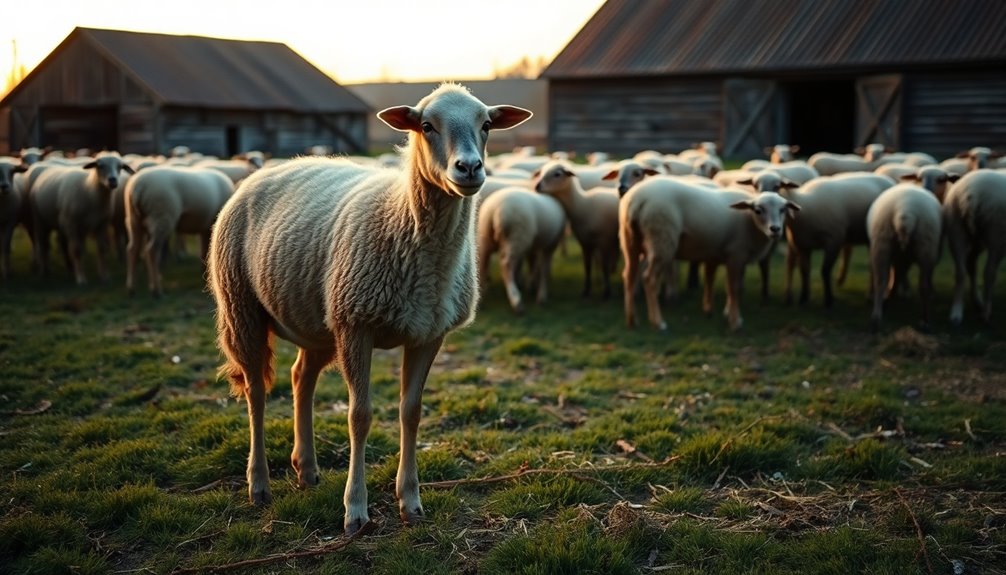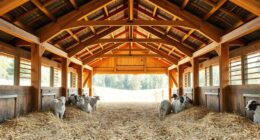As temperatures drop and activity levels change in autumn, you need to modify your livestock’s feed rations to meet their evolving energy needs. Focus on increasing energy-dense ingredients like grains and high-quality protein sources, and tweak rations gradually to avoid digestive issues. Monitor their body condition and behavior closely to ensure they stay healthy and balanced. To learn more secrets on fine-tuning your livestock diet during this season, keep exploring these strategies.
Key Takeaways
- Increase feed energy density with grains, fats, or molasses to meet the higher maintenance needs in cooler weather.
- Adjust rations gradually by 5-10% to prevent digestive upset during seasonal changes.
- Monitor activity levels and body condition to tailor feed intake appropriately for changing energy requirements.
- Provide mineral and vitamin supplements to support overall health and productivity during autumn.
- Keep detailed records of feed adjustments and animal responses to optimize rations throughout the season.
Assessing Your Livestock’s Changing Energy Requirements
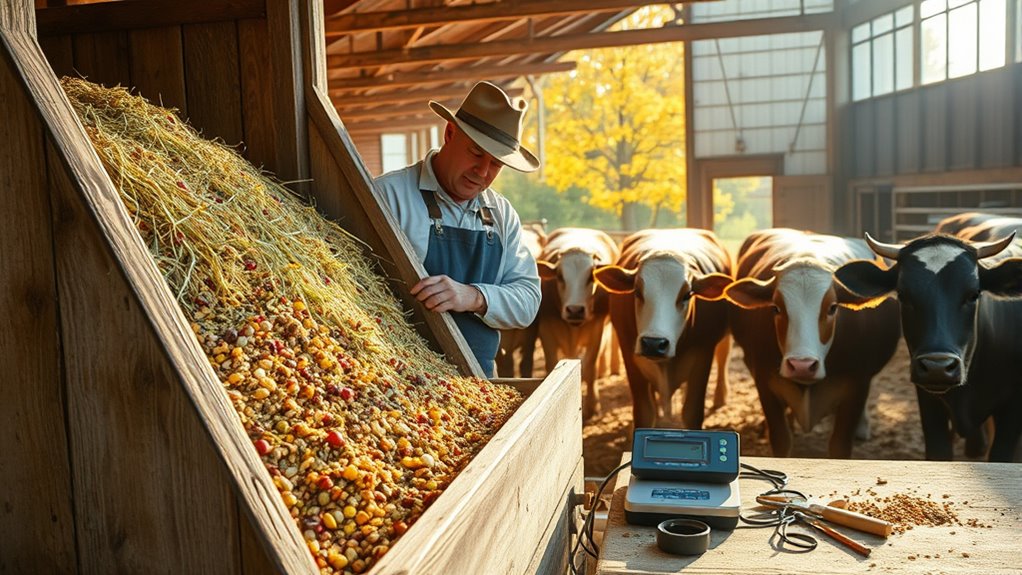
Have you noticed your livestock’s activity levels or condition changing as autumn approaches? You might see them becoming less energetic or their coats thickening. These signs indicate their energy needs are shifting from the demands of summer growth to preparing for colder weather. It’s essential to evaluate their current body condition and activity levels to determine if they require more energy intake. Pay attention to weight changes, coat condition, and overall vigor. As days shorten and temperatures drop, their bodies will need extra fuel to maintain warmth and support imperative functions. Incorporating insights from nutritional benefits can help you tailor their diet effectively. Regular assessments help you adjust feed rations accurately, ensuring your animals stay healthy and productive through the season’s shift. Staying attentive now prevents future issues and keeps your livestock in prime condition.
Selecting Nutrient-Dense Feed Ingredients for Autumn
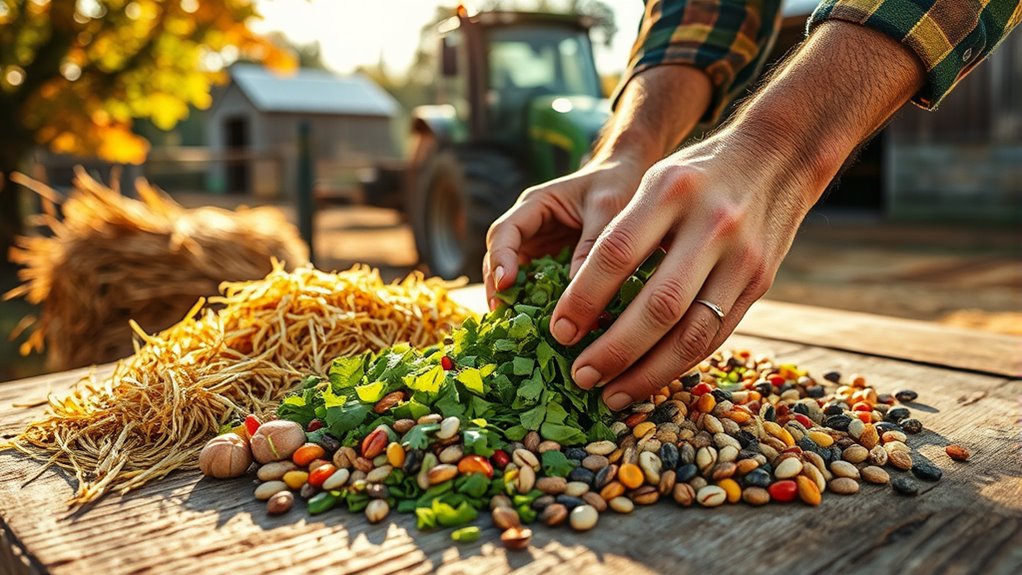
As you assess your livestock’s changing energy needs in autumn, it’s also important to focus on the quality of the feed ingredients you select. Nutrient-dense feeds help meet energy demands efficiently. Look for ingredients that provide high-quality protein, such as soybean meal or alfalfa. Incorporate energy-rich grains like corn or barley to boost calorie intake. Choose mineral and vitamin supplements that enhance overall health and productivity. Finally, consider feed additives like molasses or fats, which can increase energy density without bulk. Prioritizing these ingredients guarantees your livestock receives ideal nutrition during autumn’s cooler days. Using efficient feed options can maximize energy utilization and reduce waste. By selecting nutrient-dense options, you support healthy weight maintenance and performance, preparing animals for upcoming seasonal challenges. Proper ingredient choices are key to a successful transition into autumn.
Adjusting Rations Based on Temperature and Activity Levels
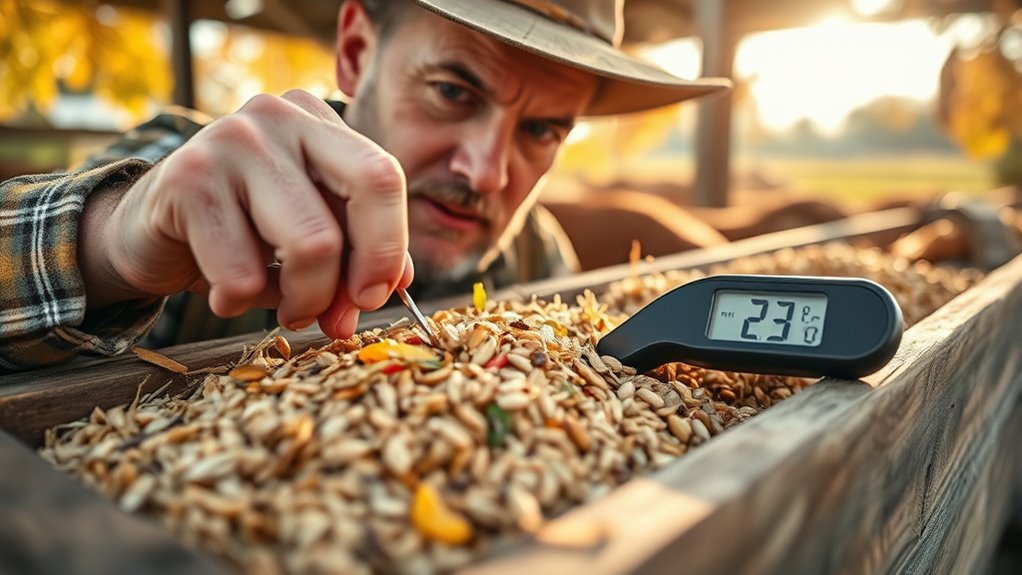
Temperature and activity levels substantially influence your livestock’s energy requirements during autumn. When temperatures drop, your animals need more energy to maintain body heat, so you should increase their feed intake accordingly. Conversely, if the weather remains mild, their energy needs decrease, and you can adjust rations downward to prevent overfeeding. Activity levels also matter; animals that are more active, such as those grazing longer hours or working animals, burn more calories and require higher energy feeds. Monitor their behavior and adjust feed rations to match their activity levels and the prevailing weather conditions. By fine-tuning rations based on these factors, you help maintain ideal body condition and ensure your livestock stay healthy and productive through the season.
Monitoring Animal Health and Performance During Transition
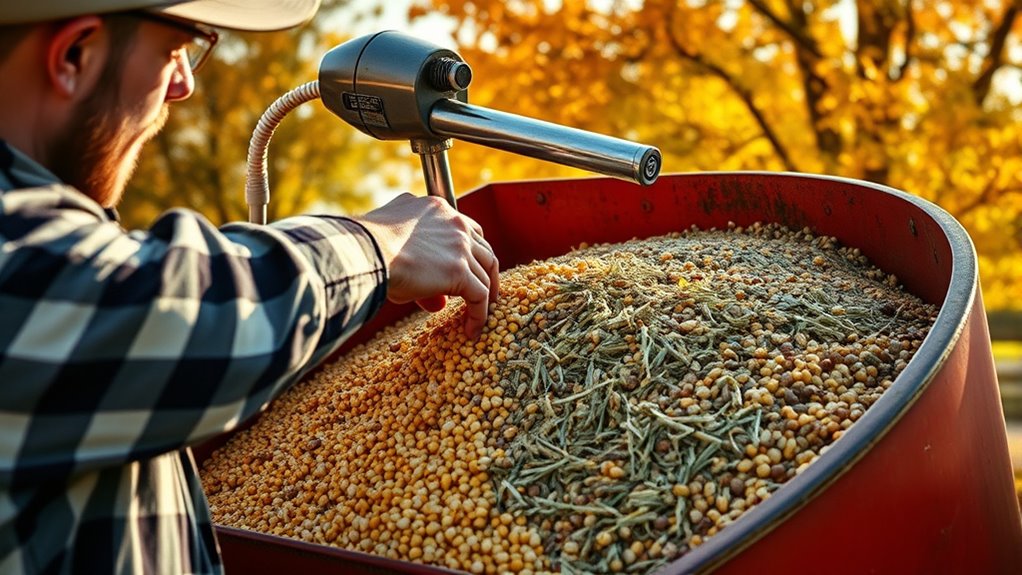
Monitoring your animals’ health and performance is essential to guarantee they respond well to changes in feed and environment. Regular observation helps you catch issues early and adjust accordingly. Focus on these key areas:
- Track feed intake daily to ensure animals are eating enough without overeating.
- Watch for changes in body condition, noting weight gain or loss.
- Monitor behavior for signs of discomfort, lethargy, or stress.
- Check manure consistency to identify digestive issues promptly.
- Stay informed about vetted health and performance indicators to make evidence-based decisions.
Tips for Implementing and Tracking Feed Adjustments
Implementing and tracking feed adjustments requires careful planning and consistent record-keeping. Before making changes, set clear goals based on your animals’ energy needs and current conditions. Start by adjusting feed gradually—about 5-10% at a time—to prevent digestive upset. Keep detailed records of each adjustment, noting dates, amounts, and observed animal responses. Use a journal or digital tools to track intake, weight changes, and behavior. Regularly review your records to evaluate the effectiveness of your adjustments, and be ready to tweak as needed. Consistency is key; avoid making multiple changes simultaneously. Communicate with your team to ensure everyone understands the plan. Incorporating wall organization systems can help keep feed and equipment organized, supporting your disciplined approach and ensuring your feed management remains efficient. This disciplined approach helps you optimize energy intake while maintaining animal health and performance.
Frequently Asked Questions
How Often Should I Re-Evaluate My Livestock’s Energy Needs in Autumn?
You should re-evaluate your livestock’s energy needs every 2 to 4 weeks during autumn. As temperatures drop and daylight hours change, their requirements shift. Regularly monitor their body condition, activity levels, and weight gain to guarantee they’re getting enough energy. Adjust rations accordingly to prevent weight loss or excess fat, keeping them healthy and productive throughout the season. Consistent evaluation helps you respond promptly to their changing needs.
What Are Signs of Overfeeding or Underfeeding During Seasonal Transition?
If your livestock are sluggish as if weighed down by invisible bags, or overly energetic like they’re about to burst, you’re likely overfeeding or underfeeding. Watch for excessive belly fat, lethargy, or signs of weight loss, which signal imbalance. Rapid changes in coat condition or uneven energy levels also reveal feeding issues. Stay attentive, and re-evaluate your rations immediately to keep them healthy and thriving through seasonal shifts.
How Do Different Breeds Vary in Their Autumn Energy Requirements?
Different breeds vary in their autumn energy needs based on their size, metabolism, and activity levels. Larger breeds typically require more energy to maintain body heat and activity, while smaller or more efficient breeds may need less. You should observe their body condition and energy levels to adjust rations accordingly. By tailoring feed based on breed-specific traits, you guarantee *maximum* health and performance during seasonal changes.
Are There Specific Supplements Recommended for Autumn Feeding Adjustments?
Think of supplements as the fuel additives that keep your farm machinery running smoothly during harvest. For autumn, you should consider energy-rich options like fat supplements or molasses to boost caloric intake. Protein supplements, such as soybean meal, help maintain muscle. Vitamins and minerals, like selenium or biotin, support overall health. Always tailor your choices to your animals’ specific needs, consulting a veterinarian for precise recommendations.
How Can I Balance Cost-Efficiency With Nutritional Quality in Feed Choices?
You can balance cost-efficiency with nutritional quality by selecting high-quality ingredients that provide essential nutrients without unnecessary extras. Opt for locally available feeds to reduce costs and compare prices to find the best value. Incorporate forage and by-products that meet energy and protein needs, and avoid overfeeding. Regularly monitor animal health and performance, adjusting rations as needed to guarantee they’re both economical and nutritious.
Conclusion
As the seasons shift, subtle changes in your livestock’s energy needs become a gentle reminder to stay attentive. By carefully adjusting your feed rations, you guarantee their well-being and optimize performance without overwhelming them. Think of it as a delicate dance—small, thoughtful steps can lead to healthier, more resilient animals. Embrace these seasonal adjustments as a natural part of your stewardship, guiding your herd smoothly through autumn’s quiet progression.

